译林牛津版高中英语Book 8 Unit 3 The world of colours and light Project教学课件 (共31张PPT)
文档属性
| 名称 | 译林牛津版高中英语Book 8 Unit 3 The world of colours and light Project教学课件 (共31张PPT) | 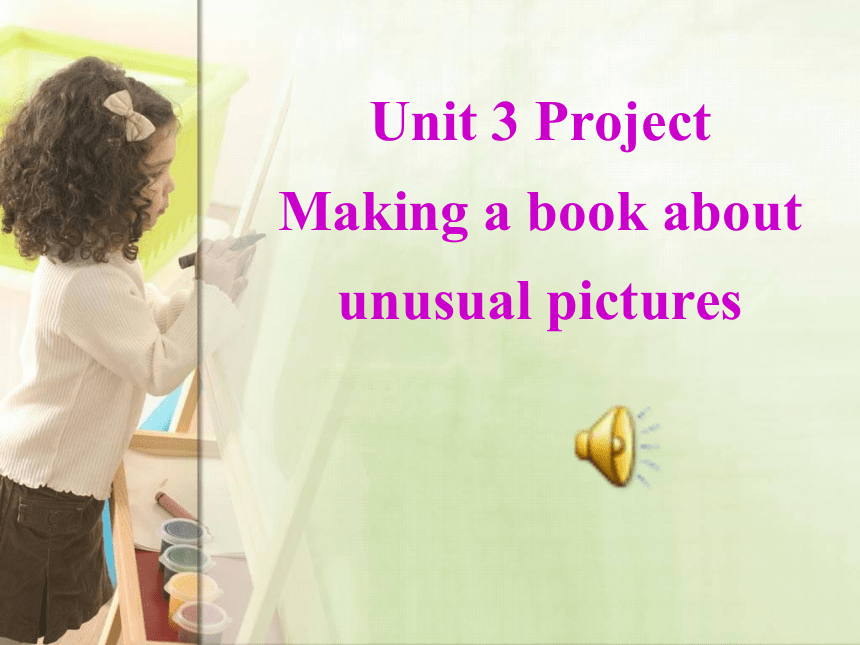 | |
| 格式 | zip | ||
| 文件大小 | 1.2MB | ||
| 资源类型 | 教案 | ||
| 版本资源 | 牛津译林版 | ||
| 科目 | 英语 | ||
| 更新时间 | 2018-12-03 19:58:21 | ||
图片预览

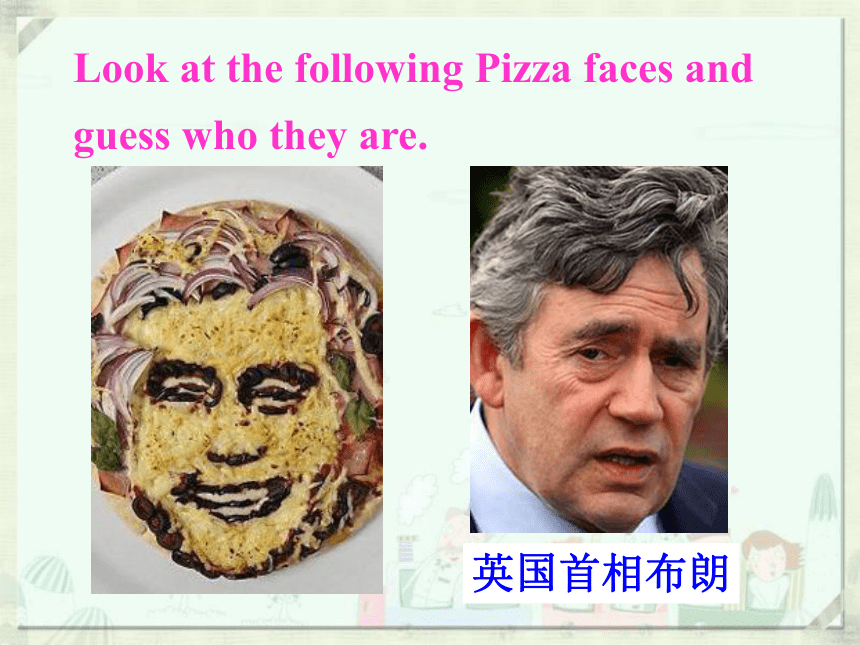
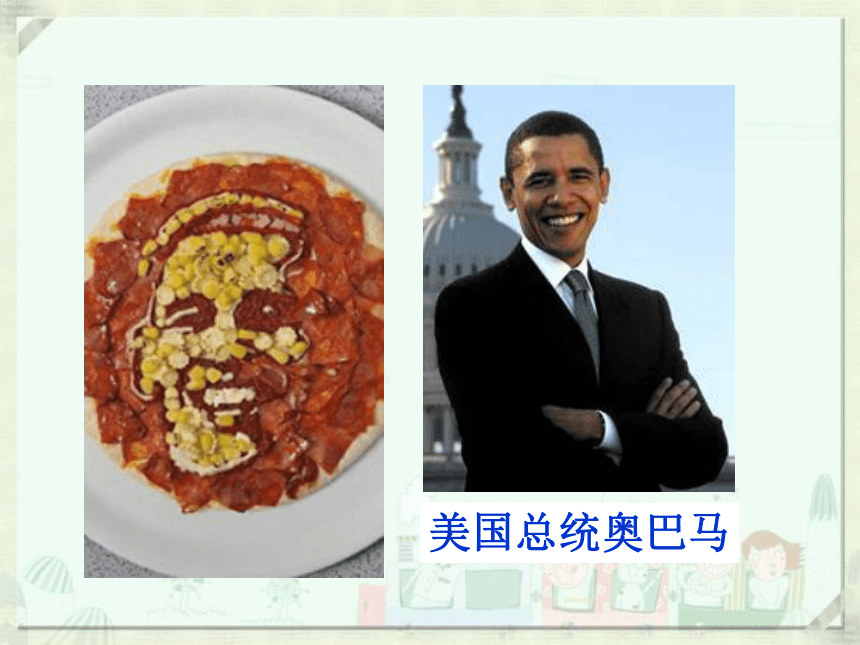
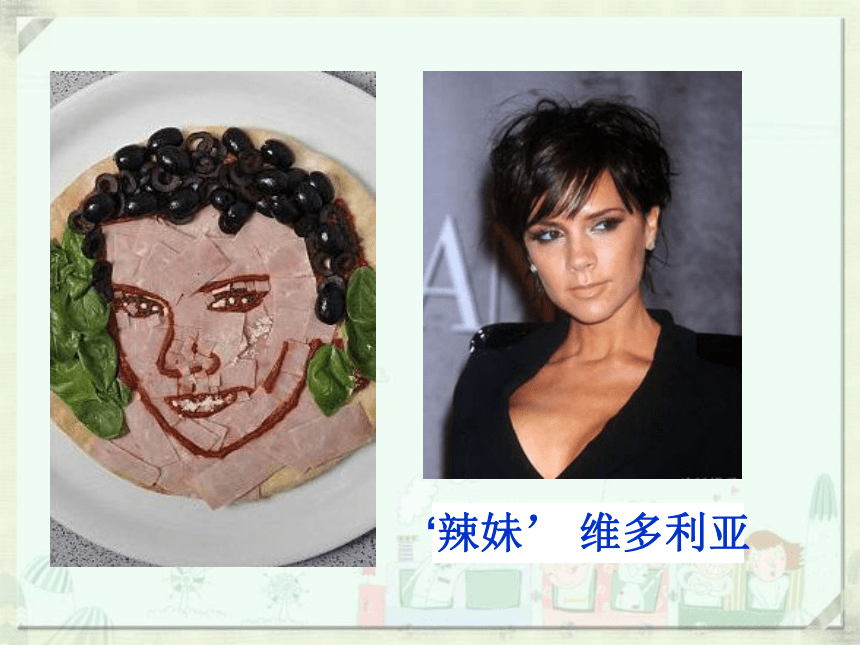
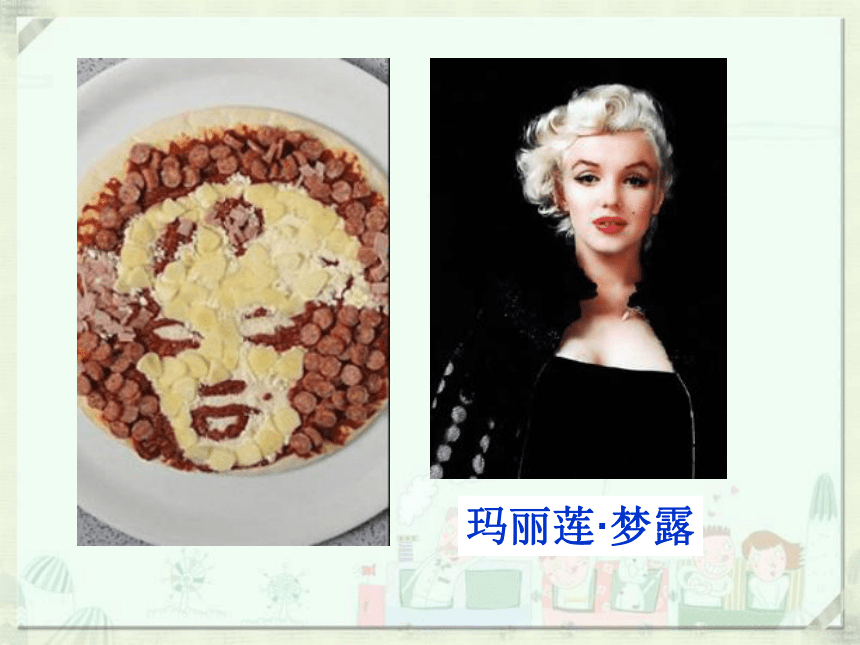
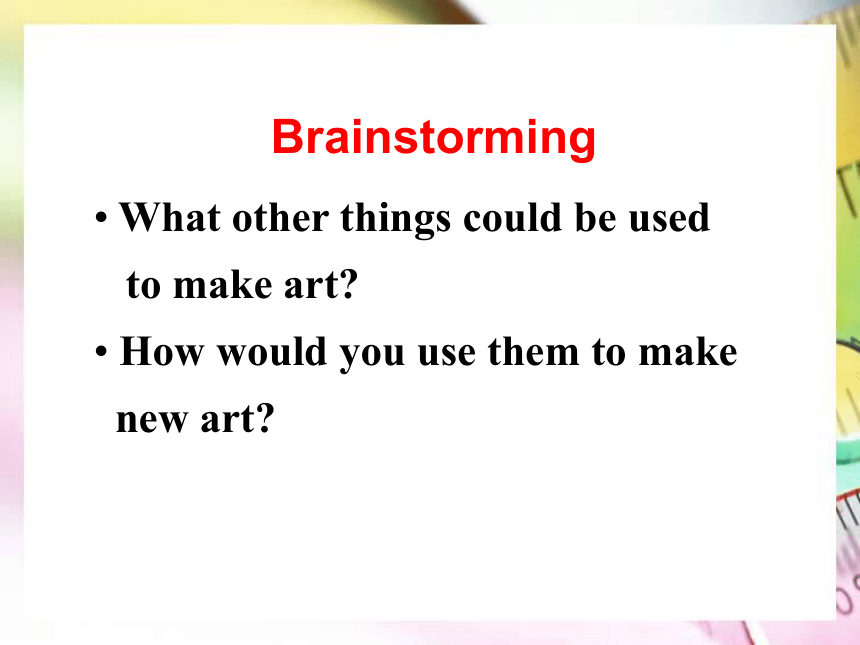
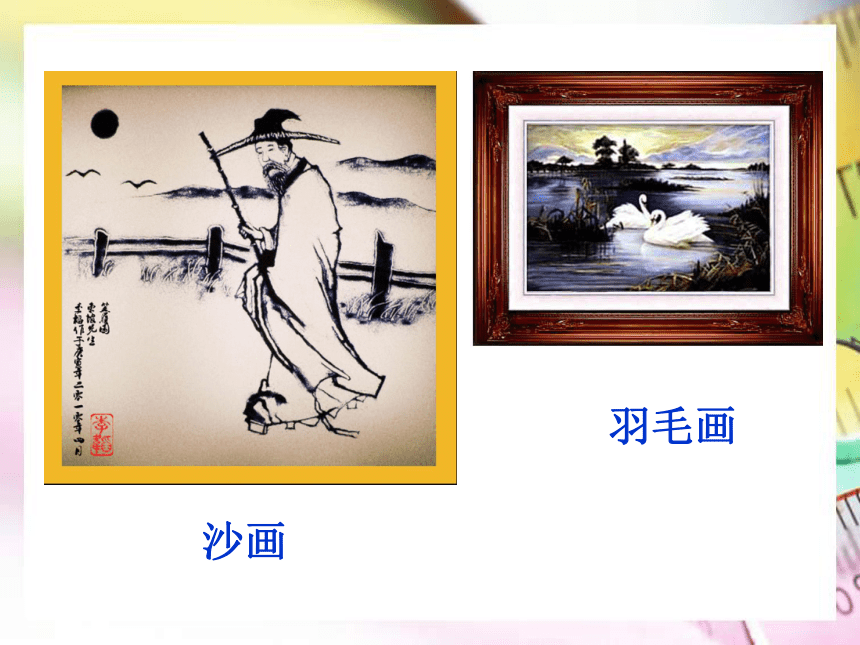
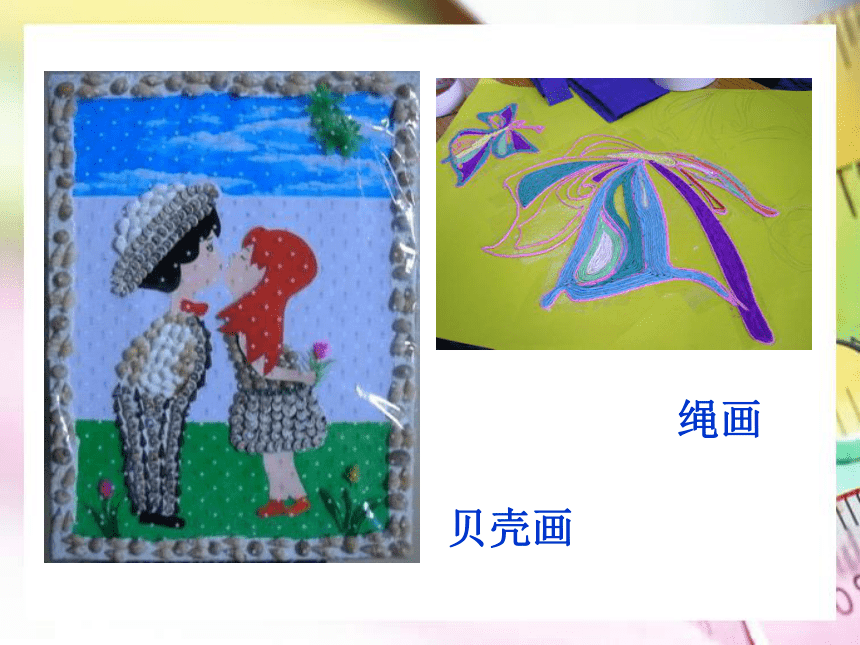
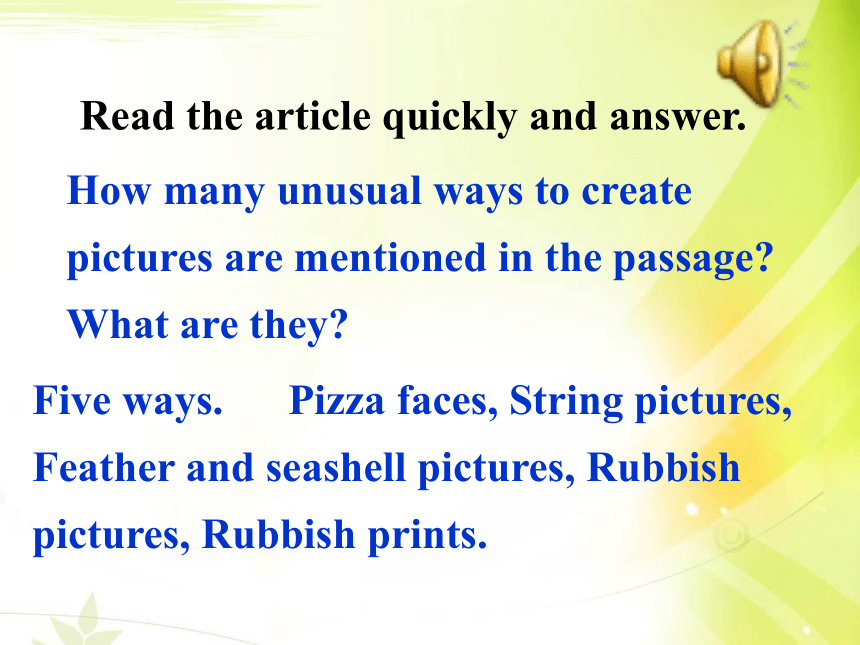
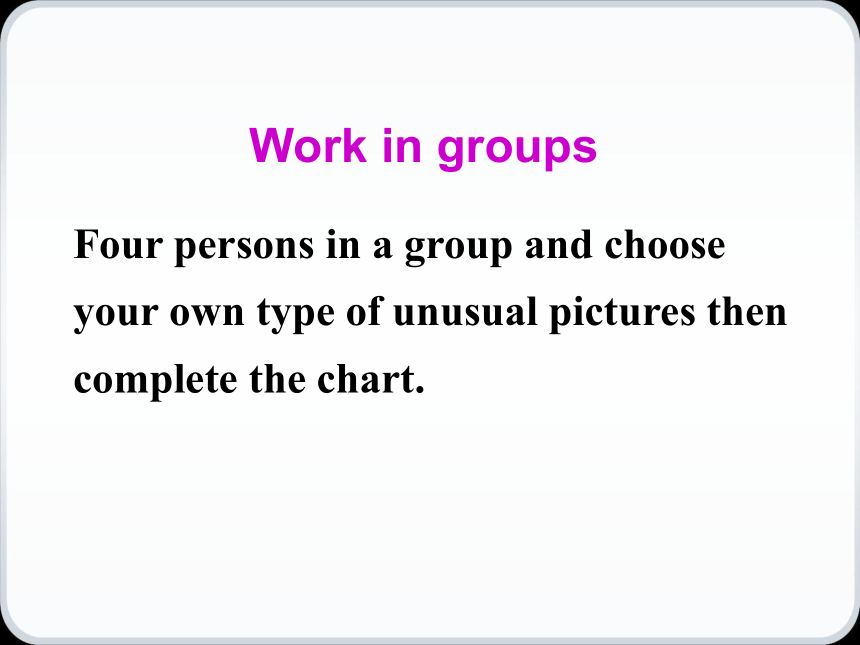
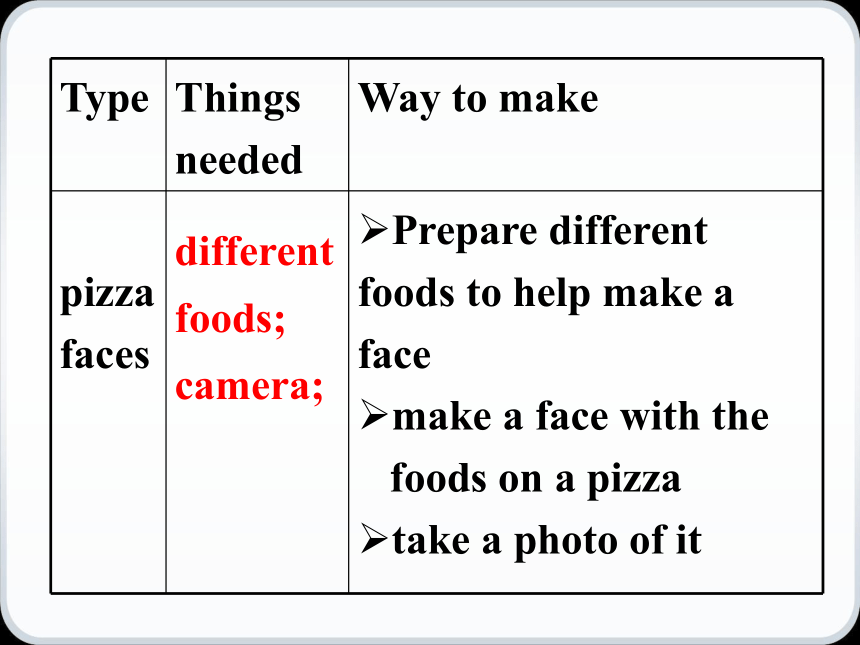
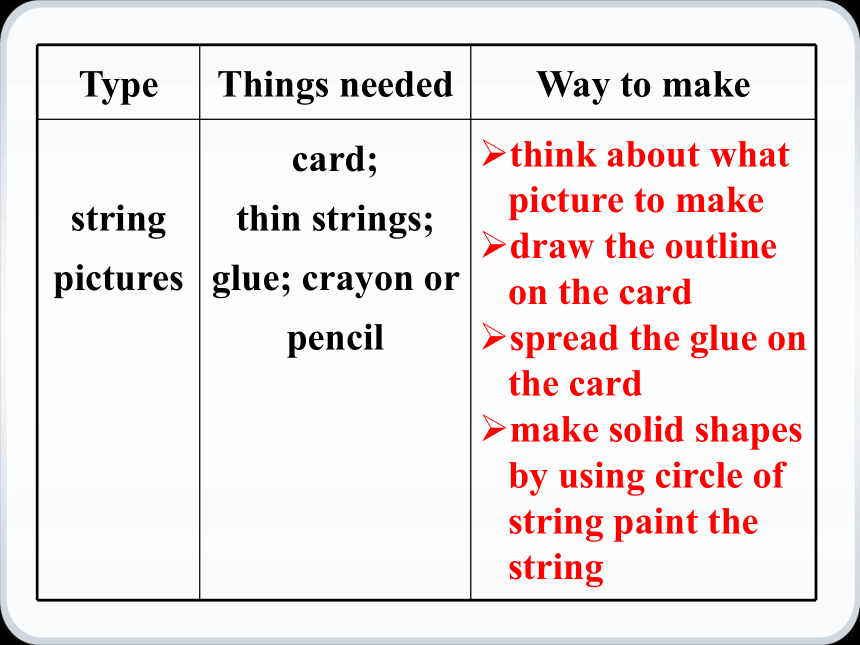
文档简介
课件31张PPT。Unit 3 Project
Making a book about unusual pictures Look at the following Pizza faces and guess who they are.英国首相布朗美国总统奥巴马‘辣妹’ 维多利亚玛丽莲·梦露Brainstorming What other things could be used
to make art?
How would you use them to make
new art?沙画羽毛画贝壳画绳画How many unusual ways to create
pictures are mentioned in the passage?
What are they?Read the article quickly and answer.Five ways. Pizza faces, String pictures, Feather and seashell pictures, Rubbish pictures, Rubbish prints.Work in groupsFour persons in a group and choose your own type of unusual pictures then complete the chart.different foods; camera;think about what
picture to make
draw the outline
on the card
spread the glue on
the card
make solid shapes
by using circle of
string paint the
stringfeather and seashell picturesrubbish, including plastic; aluminium, cloth and paper; strong paper or card; strong glue put the rubbish
on a card
stick the rubbish
onto the card
spread the different
sections of the
picture with paintrubbish prints dip one end of a tin
into paint and use it to
make circles on the
card
use old pieces of cloth
as brushes or wrinkle
the cloth together to
form a pattern
press the painted
rubbish on a card
to make different
shapes重点词汇You can lay all the pieces out on the card before you stick them down.
stick vt. 粘住,粘贴
e.g. We used glue to stick the broken pieces together.
我们用胶把碎片粘到一起。stick 也可作不及物动词
e.g. What’s wrong with this stamp? It
won’t stick.
这邮票怎么回事?粘不住了。[拓展]
1. stick down 贴好
e.g. The label’s coming off. Can you stick
it down again?
2. stick to 坚持
e.g. If you stick to the truth, you’ll have
nothing to fear.
He will stick to his task until it’s
finished. [联想] stick还可作名词,表示“树枝,棒,棍;手杖”。
e.g. Police said that the child had been
beaten with a stick.
At 84 he’s still quite active, although
he walks with the aid of a stick.难句解析 Choose small seashells so they will
not be very heavy when they are
stuck onto the card. (P47)
1) 句子结构分析:此句中,Choose small shells是主句;so they will not be very heavy ...是目的状语从句,when they are stuck onto the card是目的状语从句中的时间状语从句。2) 语言知识分析:
Choose small shells so they will not be very heavy意为“选择小贝壳,它们就不会很重”。“祈使句+so+句子”表示一种条件和目的的关系,相当于“If you do sth. +句子”。[拓展]
“祈使句+so+句子”结构中的so也可用and替换。与此类似的还有:“祈使句+ or / otherwise+句子”结构,表示“警告”,意为“如果不……,就会……;要(应该)……,否则就会……”。
e.g. Work hard, or you will lag behind.2. There are many other things that you can use to make unusual pictures, so why not have a go at some of the ideas above and then try out some ideas of your own? (P47)1) 句子结构分析:此句中,There are many other things是主句,that you can use to make unusual pictures是定语从句,修饰other things;to make unusual pictures是不定式短语作目的状语;so why not ...为结果状语从句;... and then ...连接后面句子中两个并列的谓语。2) 语言知识分析:
“why not have a go at some of the ideas above and then try out some ideas of your own?”意为“为什么不试一试上面的点子,然后试试你自己的呢?”。“Why not do sth.”为疑问句“Why don’t you do sth.”的省略形式,意为“为什么不做某事”,表示建议等。根据句子及所给单词的首字母或汉语注释,写出各单词的正确形式(每空限填 一词)。
1. Every year, he won a s__________ at
school because of his excellent study.
2. He soon got accustomed to the
d________ life and made several friends.cholarshipormitory3. The speed limit is 90 miles per hour on this h______.
4. What percentage of the students are
a________ to colleges?
5. John was asked to deliver a speech on
the g_________.
6. The plane climbed to a h______ of ten
thousand meters.ighwaydmittedraduation eight7. He falls asleep as soon as his head hits
the p______.
8. The small g______ is losing its
customers to the new supermarket.
9. When they got home, Jane cooked
their dinner in the m_________ oven.illowroceryicrowave10. Some of his paintings are on show
in the local art ______ (画廊).
11. Oh, it sounds like you really get a
_______ (便宜货).
12. Nobody can ignore the fact that
the ___________ (实验) is a success.gallerybargainexperiment In 1826, a Frenchman named Niepce need pictures on his business .But he was not a good?artists. So he invented a very simple camera. He?put?it in a window of her house and took a picture of his?garden. That was the first photo. The next importantance date in the history of photography (摄影术) was in 1837. That year, Daguerre, another Frenchman, took a picture in his reading room. He used a new kind of camera in a different way. In his picture your could see everything very clear, even the smaller thing. This kind of photo was calling a Daguerreotype.
Making a book about unusual pictures Look at the following Pizza faces and guess who they are.英国首相布朗美国总统奥巴马‘辣妹’ 维多利亚玛丽莲·梦露Brainstorming What other things could be used
to make art?
How would you use them to make
new art?沙画羽毛画贝壳画绳画How many unusual ways to create
pictures are mentioned in the passage?
What are they?Read the article quickly and answer.Five ways. Pizza faces, String pictures, Feather and seashell pictures, Rubbish pictures, Rubbish prints.Work in groupsFour persons in a group and choose your own type of unusual pictures then complete the chart.different foods; camera;think about what
picture to make
draw the outline
on the card
spread the glue on
the card
make solid shapes
by using circle of
string paint the
stringfeather and seashell picturesrubbish, including plastic; aluminium, cloth and paper; strong paper or card; strong glue put the rubbish
on a card
stick the rubbish
onto the card
spread the different
sections of the
picture with paintrubbish prints dip one end of a tin
into paint and use it to
make circles on the
card
use old pieces of cloth
as brushes or wrinkle
the cloth together to
form a pattern
press the painted
rubbish on a card
to make different
shapes重点词汇You can lay all the pieces out on the card before you stick them down.
stick vt. 粘住,粘贴
e.g. We used glue to stick the broken pieces together.
我们用胶把碎片粘到一起。stick 也可作不及物动词
e.g. What’s wrong with this stamp? It
won’t stick.
这邮票怎么回事?粘不住了。[拓展]
1. stick down 贴好
e.g. The label’s coming off. Can you stick
it down again?
2. stick to 坚持
e.g. If you stick to the truth, you’ll have
nothing to fear.
He will stick to his task until it’s
finished. [联想] stick还可作名词,表示“树枝,棒,棍;手杖”。
e.g. Police said that the child had been
beaten with a stick.
At 84 he’s still quite active, although
he walks with the aid of a stick.难句解析 Choose small seashells so they will
not be very heavy when they are
stuck onto the card. (P47)
1) 句子结构分析:此句中,Choose small shells是主句;so they will not be very heavy ...是目的状语从句,when they are stuck onto the card是目的状语从句中的时间状语从句。2) 语言知识分析:
Choose small shells so they will not be very heavy意为“选择小贝壳,它们就不会很重”。“祈使句+so+句子”表示一种条件和目的的关系,相当于“If you do sth. +句子”。[拓展]
“祈使句+so+句子”结构中的so也可用and替换。与此类似的还有:“祈使句+ or / otherwise+句子”结构,表示“警告”,意为“如果不……,就会……;要(应该)……,否则就会……”。
e.g. Work hard, or you will lag behind.2. There are many other things that you can use to make unusual pictures, so why not have a go at some of the ideas above and then try out some ideas of your own? (P47)1) 句子结构分析:此句中,There are many other things是主句,that you can use to make unusual pictures是定语从句,修饰other things;to make unusual pictures是不定式短语作目的状语;so why not ...为结果状语从句;... and then ...连接后面句子中两个并列的谓语。2) 语言知识分析:
“why not have a go at some of the ideas above and then try out some ideas of your own?”意为“为什么不试一试上面的点子,然后试试你自己的呢?”。“Why not do sth.”为疑问句“Why don’t you do sth.”的省略形式,意为“为什么不做某事”,表示建议等。根据句子及所给单词的首字母或汉语注释,写出各单词的正确形式(每空限填 一词)。
1. Every year, he won a s__________ at
school because of his excellent study.
2. He soon got accustomed to the
d________ life and made several friends.cholarshipormitory3. The speed limit is 90 miles per hour on this h______.
4. What percentage of the students are
a________ to colleges?
5. John was asked to deliver a speech on
the g_________.
6. The plane climbed to a h______ of ten
thousand meters.ighwaydmittedraduation eight7. He falls asleep as soon as his head hits
the p______.
8. The small g______ is losing its
customers to the new supermarket.
9. When they got home, Jane cooked
their dinner in the m_________ oven.illowroceryicrowave10. Some of his paintings are on show
in the local art ______ (画廊).
11. Oh, it sounds like you really get a
_______ (便宜货).
12. Nobody can ignore the fact that
the ___________ (实验) is a success.gallerybargainexperiment In 1826, a Frenchman named Niepce need pictures on his business .But he was not a good?artists. So he invented a very simple camera. He?put?it in a window of her house and took a picture of his?garden. That was the first photo. The next importantance date in the history of photography (摄影术) was in 1837. That year, Daguerre, another Frenchman, took a picture in his reading room. He used a new kind of camera in a different way. In his picture your could see everything very clear, even the smaller thing. This kind of photo was calling a Daguerreotype.
